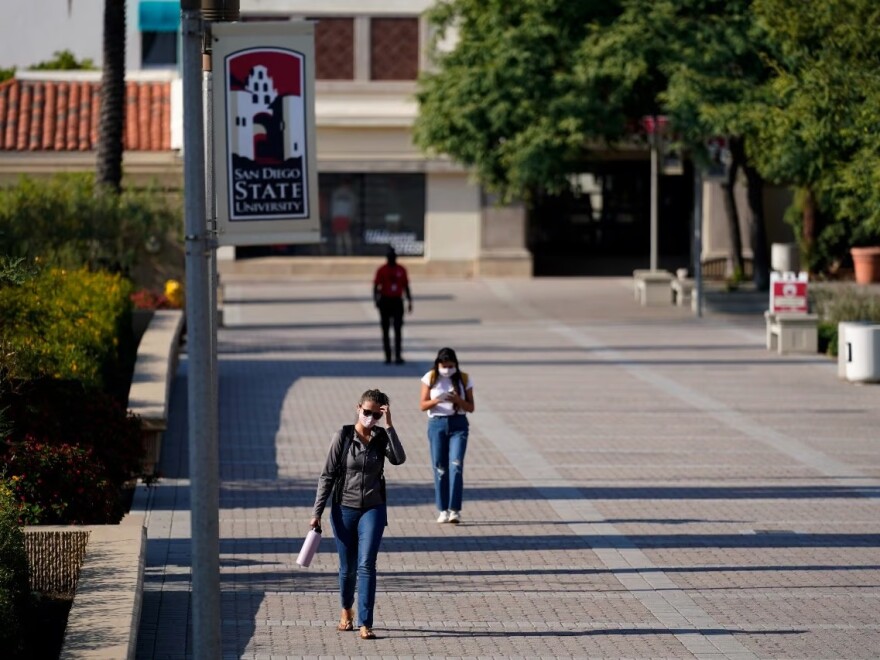The study conducted by an independent national consulting firm found that professors, instructors, librarians, counselors and coaches in the 23-campus system are, on average, paid market rates compared with others across the country, although some are underpaid depending on their discipline, job and location.
For example, CSU has 3,055 associate professors who average $104,315 annually — 2% more than the $103,890 national market salary median. However, among the nearly 4,900 higher-ranked full professors in CSU, they average $122,069 annually — 2% less than the market median.
The salary study was presented during the CSU board of trustees meeting. It could influence upcoming contract talks with the faculty union, as well as discussions with the governor’s office and the Legislature over providing more funding to help CSU pay its employees.
Interim Chancellor Jolene Koester said the next step is for the chancellor’s office to meet with the California Faculty Association, the faculty union, and “bargain in good faith” with them as both sides understand the data from the study.
The study compared salaries at each Cal State campus against other similar or comparable universities across the country. Neither the UC nor the state’s community colleges were included because faculty at those institutions have different missions and work expectations. For example, UC faculty are predominantly focused on research. A similar study of CSU staff salaries was released last year and found that those non-faculty employees in clerical, information technology, health care and custodial jobs were underpaid.
“While the numbers purely show that CSU faculty on the average is paid pretty much on the median with comparable institutions across the United States, California is one of the highest-cost states,” trustee Romy Saballius said. “We should keep this in mind, that the dollar amount alone doesn’t reflect whether it’s adequate, fair or good pay.”
The study also included a survey of faculty members and found that few felt they were paid fairly by the nation’s largest public university system. Between 70% and 80% of faculty said they were dissatisfied with their pay. Only 5% said they were paid fairly.
This could be due to the academic discipline they teach or their campus location. For example, CSU faculty in business and management disciplines are paid 14% below market rates, according to the study. The average salary for the 1,229 instructors in that field is $137,625, while the salary at other comparable universities averages $161,081.
Faculty who live in the San Jose, East Bay and San Francisco regions also have below-market-rate salaries. For example, faculty at San Jose State average $111,948 annually — 11% below the $129,286 median market salary for that area. Those campuses are the least competitive in faculty salaries because they are in the highest-cost markets, said Lyn Harper, a senior principal with Mercer, the consulting firm that conducted the study.
When it comes to benefits, CSU ranked either first or second in the country among peer universities for retirement, medical, post-retirement medical and dental benefits. CSU’s post-retirement medical plan is not common, Harper said. CSU also ranked highly for paid leave, life insurance, short- and long-term disability benefits.
The study recommended that CSU change its base pay so that it aligns with both discipline and location.
“Because all of California is above the national average, we suggest reflecting those regional differences when considering discipline,” Harper said.
Other recommendations included creating a separate merit-based budget and setting clear and consistent guidelines for placing employees within a range for wage promotion and awards.
“It is important, especially at the top rank, that there is a mechanism for faculty members to advance in their pay range to recognize their experience and contribution,” Harper said, adding that 100% of faculty surveyed in the study said they wanted merit pay.
The survey also did not find significant disparities in pay by race. However, some small pay disparity by gender exists among tenure-track faculty groups, where women are paid 0.5% less than male professors.
But trustee Leslie Gilbert-Lurie expressed concern that CSU is comparing itself against other institutions that are mostly not located in high-cost California or New York. For example, the State University of New York’s system was excluded from the study because they don’t participate in the College and University Professional Association of Human Resources annual collection of faculty data survey.
No matter which universities are included, CSU attitudes are more important, Gilbert-Lurie said, referring to the 80% of faculty who said they aren’t paid fairly. “It doesn’t make me feel better that we pull out a survey of institutions in other states and then say, ‘Well, ‘you’re OK.’ They don’t feel OK, and it’s no wonder to us that people living on these salaries in our state are finding it hard to make ends meet.”
EdSource is a California-based independent nonprofit organization founded in 1977, dedicated to providing analysis on key education issues facing the state and nation.



